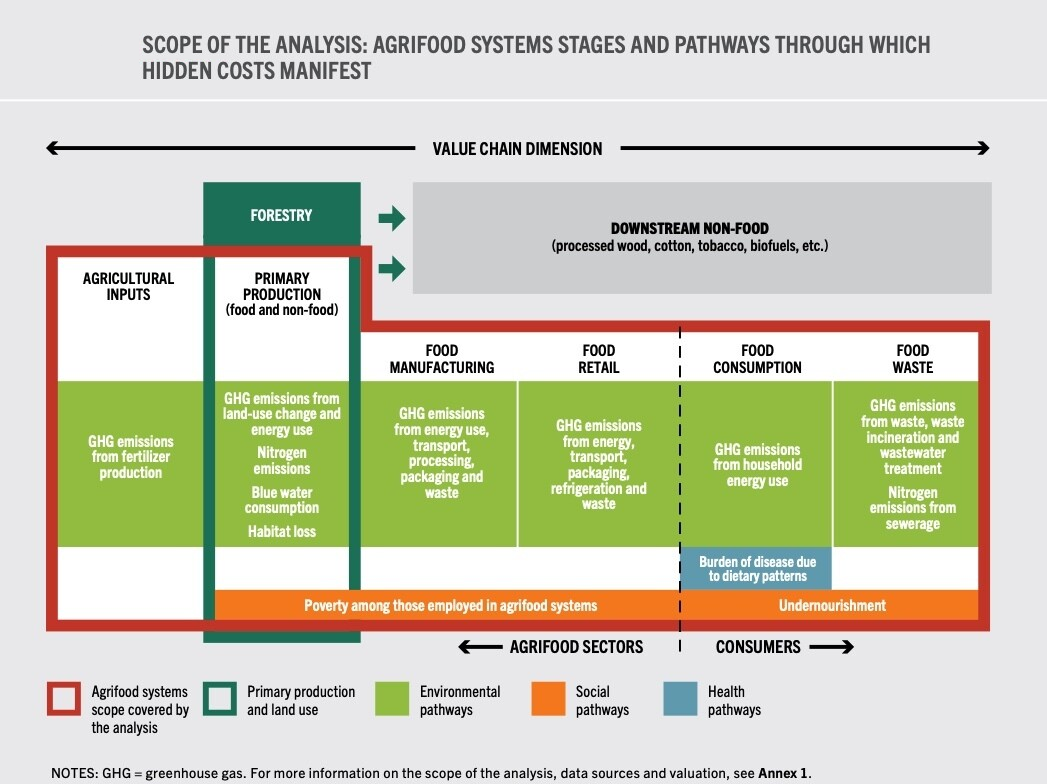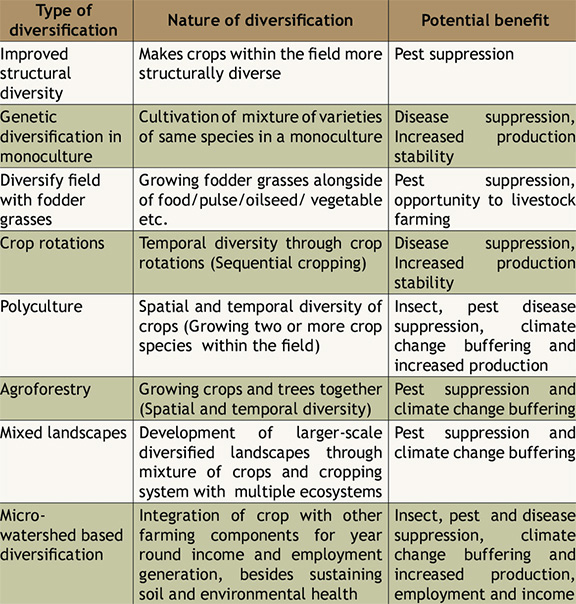Agriculture
Uncovering The Hidden Costs of Agrifood Systems
This editorial is based on “The need to transform agri-food systems ” which was published in The Hindu on 05/12/2023. It talks about the hidden costs of agri-food systems and explores their impact on health, environment, and society.
For Prelims: State of Food and Agriculture 2023, Food and Agriculture Organization (FAO), Purchasing Power Parity (PPP), Non-communicable diseases (NCDs), NITI Aayog, Crop Diversification, Climate-Resilient Crop Varieties, Precision Irrigation, Variable Rate Fertilization, Intergenerational justice, FAO’s True Cost Accounting Approach.
For Mains: About Hidden Costs of Agrifood Systems, Impacts of Intensive Agriculture in India, MSP affecting the Cropping Pattern, Way Forward to Make Food System Sustainable in India.
The agriculture sector, responsible for growing, processing, and distributing food, sustains jobs and livelihoods for over a billion people.
We are currently at a crucial point as we confront increasing global challenges, including issues of insufficient food availability, limited access to food, and affordability concerns. At the same time, hidden environmental, social, and health costs arise due to the negative impacts of food production and farming.
In its report, The State of Food and Agriculture 2023, the United Nations Food and Agriculture Organization (FAO) unpacks these ‘hidden costs’ of our agrifood systems and explores their impact.
What is the Hidden Cost of Food and Agriculture?
- Hidden Costs of agrifood systems include environmental costs from greenhouse gas and nitrogen emissions, water use, land-use change, health hidden costs from losses in productivity due to unhealthy dietary patterns, and social hidden costs from poverty and productivity losses associated with undernourishment.
- The State of Food and Agriculture 2023 is the FAO’s first attempt to assess the hidden costs of agrifood systems at a national level across 154 countries.
What are the Key Highlights of the Report In Global Context?
- The global quantified hidden costs of agrifood systems were approximately 12.7 trillion dollars at purchasing power parity (PPP) in 2020, equivalent to almost 10 % of world GDP in PPP terms.
- Globally, 73% of the quantified hidden costs in 2020 were associated with dietary patterns that led to obesity and non-communicable diseases (NCDs), causing labor productivity losses.
- The quantified environmental hidden costs from agriculture, accounting for more than 20% of quantified hidden costs, are equivalent to almost one-third of agricultural value added.
- On the social side, it is estimated that the incomes of the moderately poor working in agrifood systems need to increase by 57 % in low-income countries and 27 % in lower-middle-income countries, to ensure they are above the moderate poverty line.
- It highlights the urgent need to factor these costs into decision-making to transform agrifood systems.
What did the Report say in the Context of India?
- India’s total hidden costs of agrifood systems were approximately USD 1.1 trillion, the third largest in the world after China and the United States (US).
- India’s share was 8.8%, out of the global quantified USD 12.7 trillion hidden costs associated with agrifood systems, while China contributed 20% and US contributed 12.3%, as per the FAO’s report.
- In India, the burden of disease (productivity losses from dietary patterns) had the largest share (60%) among hidden costs, followed by the social cost of poverty among agrifood workers (14%) and then the environmental cost of nitrogen emissions (13%).
- It emphasizes the importance of repurposing support to transform agri-food systems to deliver healthy and environmentally sustainable diets to all.
How are Intensive Agricultural Practices Impacting the Hidden Costs in India?
- Impact on Society:
- Collapse of Indigenous System: The introduction of seeds bought from multinational corporations and the use of fertilizers have eroded seed sovereignty, disrupted Indigenous knowledge systems, and led to a transition from a variety of crops like pulses and millets to single-crop plantations.
- On the other hand, the traditional farming approach in India boasts a broader range of crops, offering stability and aligning more with nature. In the Garhwal Himalayan region of India, Barahnaja is a crop diversification system for cultivating 12 crops in a year.
- Increased Debtness: This privatization and deregulation of agricultural inputs also increased indebtedness among agrarian households. In 2013, the debt-to-asset ratio of a farmer’s household in India was 630% higher than in 1992.
- Low Agrarian Income: Agriculture in India has increasingly become unviable, the average monthly household income of a farming household sits at ₹10,816 only.
- Collapse of Indigenous System: The introduction of seeds bought from multinational corporations and the use of fertilizers have eroded seed sovereignty, disrupted Indigenous knowledge systems, and led to a transition from a variety of crops like pulses and millets to single-crop plantations.
- Impact on Ecology:
- Decline in Soil Fertility: Practices like monoculture and intensive farming without proper crop rotation can deplete specific nutrients from the soil.
- Excessive Extraction of Groundwater: Agriculture in India heavily relies on irrigation to ensure consistent and sufficient water supply for crops. This trend resulted in excessive extraction of groundwater which has adverse ecological consequences.
- Impact on Health:
- The expansion of rice and sugarcane cultivation affects biodiversity, increases the pressure on groundwater resources, and contributes to air and water pollution.
What is the Way Forward to Minimize the Hidden Costs of Agrifood Systems in India?
- Crop Diversification: Promote crop diversification and rotation to enhance soil fertility, reduce the risk of pests and diseases, and improve overall resilience in agriculture.
- Cultivating Climate-Resilient Crop Varieties: Combine traditional agricultural knowledge with modern scientific methods to identify and utilize crop varieties that have historically demonstrated resilience to local climate conditions.
- For instance, drought-tolerant maize varieties have been developed and disseminated in sub-Saharan Africa, benefiting millions of smallholder farmers.
- Precision Irrigation: It aims to maximize water use efficiency, ensuring that each drop of water contributes effectively to plant growth.
- Drip and Sprinkler irrigation is used to maximize water use efficiency and reduce environmental negative impacts.
- Variable Rate Fertilization: It is an agricultural practice that involves adjusting the application of fertilizers across a field based on variations in soil nutrient levels, crop requirements, and other relevant factors
- Variable rate fertilization can be achieved by using soil testing, remote sensing, and precision agriculture technologies to tailor fertilizer application to the specific needs of each crop and field.
- Government Policy Changes:
- Government policy changes can mitigate hidden agrifood costs through taxation, subsidies, and legislation.
- By sharing risks and responsibilities, both public and private entities can work together to manage and mitigate challenges in the agricultural sector.
- Building Justice into the Agrifood Business:
- Intergenerational Justice: Take responsibility for and address the negative historical impacts of agrifood business.
- Intragenerational Justice: It focuses on ensuring equitable distribution of resources within the same generation with fair compensation strategies for farmers.
- Interspecies Justice: Reject human exceptionalism and properly account for, protect, and regenerate the value of biodiversity and ecosystems.
- FAO’s True Cost Accounting Approach:
- The FAO’s true cost accounting approach – which values the industry’s environmental, social, health, and economic costs and benefits – can be used to tackle the hidden costs of agrifood companies.
- It will include regulating the way businesses produce, process, and promote their products.
Conclusion
As we stand at the precipice of an environmental crisis, it is evident that our current trajectory is pushing the Earth's system beyond safe and just boundaries. We possess the potential not only to avert further damage but to instigate a just and transformative shift that can recalibrate our relationship with the planet. The first crucial step lies in drawing attention to the pressing need for a profound and equitable transformation of our food system.
|
Drishti Mains Question Define the concept of hidden costs within the agrifood system. What would you suggest to make the agrifood system sustainable in the country? |
UPSC Civil Services Examination Previous Year Question (PYQ)
Prelims
Q.Which of the following factors/policies were affecting the price of rice in India in the recent Past? (2020)
- Minimum Support Price
- Government’s trading
- Government’s stockpiling
- Consumer subsidies
Select the correct answer using the code given below:
(a) 1, 2 and 4 only
(b) 1, 3 and 4 only
(c) 2 and 3 only
(d) 1, 2, 3 and 4
Ans: D
Mains
Q. What are the present challenges before crop diversification? How do emerging technologies provide an opportunity for crop diversification? (2021)







